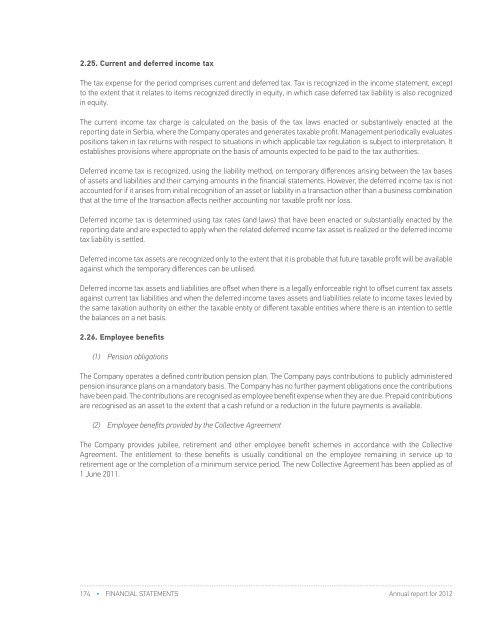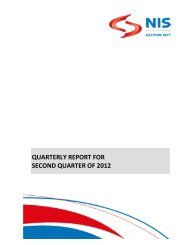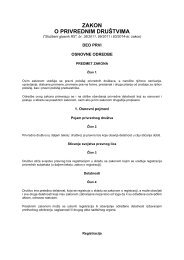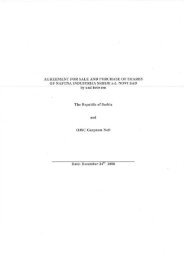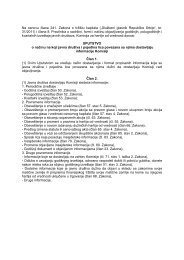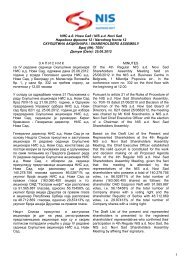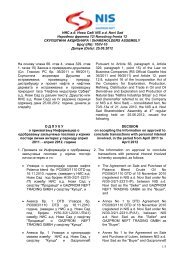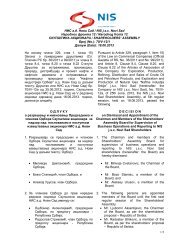FY 2012 - Investor Relations - NIS
FY 2012 - Investor Relations - NIS
FY 2012 - Investor Relations - NIS
You also want an ePaper? Increase the reach of your titles
YUMPU automatically turns print PDFs into web optimized ePapers that Google loves.
2.25. Current and deferred income taxThe tax expense for the period comprises current and deferred tax. Tax is recognized in the income statement, exceptto the extent that it relates to items recognized directly in equity, in which case deferred tax liability is also recognizedin equity.The current income tax charge is calculated on the basis of the tax laws enacted or substantively enacted at thereporting date in Serbia, where the Company operates and generates taxable profit. Management periodically evaluatespositions taken in tax returns with respect to situations in which applicable tax regulation is subject to interpretation. Itestablishes provisions where appropriate on the basis of amounts expected to be paid to the tax authorities.Deferred income tax is recognized, using the liability method, on temporary differences arising between the tax basesof assets and liabilities and their carrying amounts in the financial statements. However, the deferred income tax is notaccounted for if it arises from initial recognition of an asset or liability in a transaction other than a business combinationthat at the time of the transaction affects neither accounting nor taxable profit nor loss.Deferred income tax is determined using tax rates (and laws) that have been enacted or substantially enacted by thereporting date and are expected to apply when the related deferred income tax asset is realized or the deferred incometax liability is settled.Deferred income tax assets are recognized only to the extent that it is probable that future taxable profit will be availableagainst which the temporary differences can be utilised.Deferred income tax assets and liabilities are offset when there is a legally enforceable right to offset current tax assetsagainst current tax liabilities and when the deferred income taxes assets and liabilities relate to income taxes levied bythe same taxation authority on either the taxable entity or different taxable entities where there is an intention to settlethe balances on a net basis.2.26. Employee benefits(1) Pension obligationsThe Company operates a defined contribution pension plan. The Company pays contributions to publicly administeredpension insurance plans on a mandatory basis. The Company has no further payment obligations once the contributionshave been paid. The contributions are recognised as employee benefit expense when they are due. Prepaid contributionsare recognised as an asset to the extent that a cash refund or a reduction in the future payments is available.(2) Employee benefits provided by the Collective AgreementThe Company provides jubilee, retirement and other employee benefit schemes in accordance with the CollectiveAgreement. The entitlement to these benefits is usually conditional on the employee remaining in service up toretirement age or the completion of a minimum service period. The new Collective Agreement has been applied as of1 June 2011.Jubilee awardsThe amount of jubilee awards to be paid is determined as a number of monthly salaries based on the number ofcompleted years of service within the Company, as presented in the table below:Retirement benefitsMinimum years of servicein the CompanyCollective Labour AgreementNumber of monthly salaries10 120 1,530 235 2,540 2,5The Company shall pay to employees when they are retiring, retirement benefits equal to a maximum of three averageCompany’s salaries paid in the months preceding the retirement.The expected costs of these benefits are accrued over the period of employment.The defined benefit obligation is valued annually by independent qualified actuaries using the projected unit creditmethod. The present value of the defined benefit obligation is determined by discounting the estimated future cashoutflows using interest rates of high-quality corporate bonds that are denominated in the currency in which the benefitswill be paid and that have terms to maturity approximating to the terms of the related pension liability. Actuarial gainsand losses arising from experience adjustments, and changes in actuarial assumptions, are charged or credited toincome over the expected average remaining working lives of the related employees for pension obligations, andcharged or credited to income in full amount for jubilee awards and termination benefits.Termination benefitsTermination benefits are payable when employment is terminated before the normal retirement date, or whenever anemployee accepts voluntary redundancy in exchange for these benefits. The Company recognises termination benefitswhen it is demonstrably committed to either: terminating the employment of current employees according to a detailedformal plan without possibility of withdrawal; or providing termination benefits as a result of an offer made to encouragevoluntary redundancy. Benefits falling due more than 12 months after reporting date are discounted to present value.(3) Bonus plansThe Company recognises a liability and an expense for bonuses and profit-sharing based on an Individual performanceassessment. The Company recognizes a provision where contractually obliged or where there is a past practice thathas created a constructive obligation.2.27. Revenue recognitionRevenue comprises the fair value of the consideration received or receivable for the sale of goods and services in theordinary course of the Company’s activities. Revenue is shown net of value-added tax, excise duty, returns, rebates anddiscounts after eliminating sales within the Company.174 • FINANCIAL STATEMENTS Annual report for <strong>2012</strong>Annual report for <strong>2012</strong>FINANCIAL STATEMENTS • 175


